Published on August 2, 2022
Our partners from the Amrita Institute of Medical Sciences (AIMS) in India prove that working in a country with limited resources is not a barrier to using new technologies to treat children with heart disease. Dr. Kappanayil Mahesh and his team reproduce the heart of patients with the help of 3D printing and virtual reality, to better understand complex anatomies and operate on these cases more successfully. In July of 2022, AIMS won the Medicall Made in India Innovation Award for leveraging virtual reality technologies in patient care. The award was granted by India’s largest medical equipment exhibition.
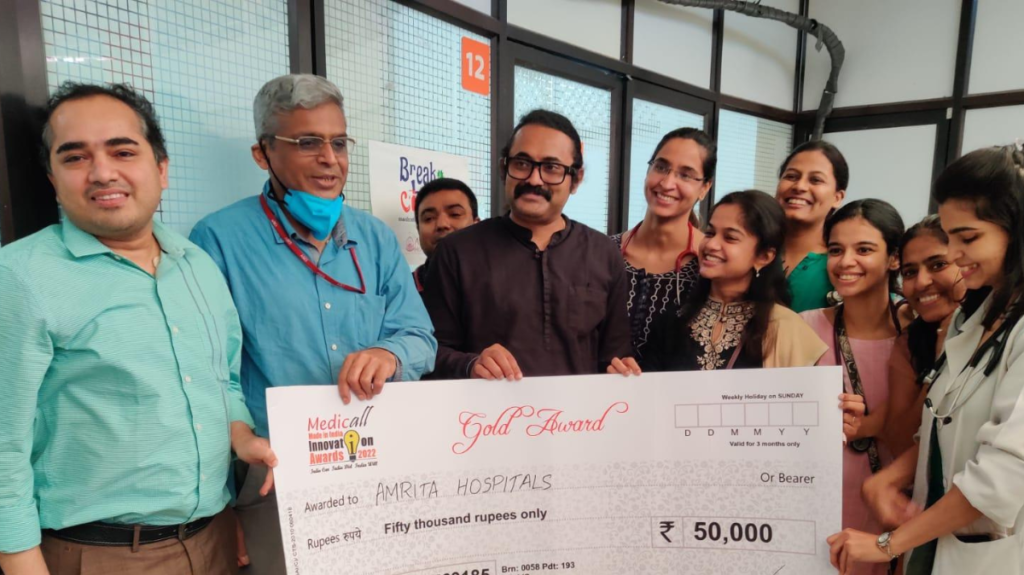
Dr. Mahesh is a true pioneer in cutting-edge innovations in healthcare in India. His pediatric cardiac congenital heart MRI program—the first one of its kind in India—provides advanced imaging of children’s hearts. The cardiac MRI program at AIMS was established after Dr. Mahesh trained on advanced imaging at Boston Children’s Hospital with the Children’s HeartLink medical volunteer team. The AIMS 3D and virtual reality labs convert heart scans into heart replicas – as physical or virtual objects.
Advancing technologies: More benefits for patients, doctors and hospitals
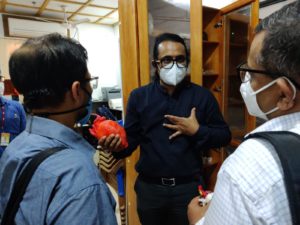
“Some children are born with very complex anatomies and we receive information about these conditions from conventional and advanced imaging such as MRI and CT. But in most cases, it’s not enough. Even experienced pediatric cardiac professionals admit that it’s hard to understand complex anatomy by viewing these images in 2D. That’s where 3D prototyping and extended reality can help,” says Dr. Mahesh. He adds that when a surgeon operates, he works in three dimensions. 3D imaging, printed or virtual, mimics what a surgeon expects to see in surgery in greater detail.
3D technologies like 3D printing have existed for three decades but in earlier years they were used in very specialized areas. In the past, 3D prints were produced by a huge machine that occupied an entire room. “Now, it’s a desktop that we have at the office,” says Dr. Mahesh. His 3D lab serves the entire hospital, not just a pediatric cardiac unit. Among their 3D prints and inventions are face masks, shields and respirators to deal with COVID; suction tube adaptors to use on babies; storage containers for lab ampules; and a replica of a football-sized tumor that was removed from the face of a teen patient. The 14-hour surgery and removal of the tumor made international headlines in 2018.
How Hari’s heart helped treat others
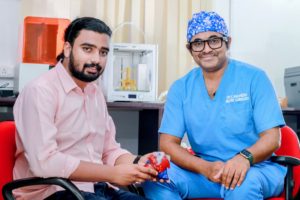
Hari, a young adult who was operated on at AIMS, became a key to setting up an in-hospital 3D lab. In 2016, Hari became the first patient for whom Dr. Mahesh used 3D printing to assist in cardiac surgery. Hari was born with a complex heart defect and surgical treatment was considered to be too risky. A replica of Hari’s heart allowed the AIMS team to see his heart from the inside and operate on him successfully.
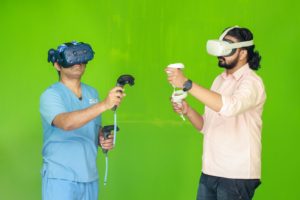
Now, he is a university student and helps Dr. Mahesh with 3D visualization including developing new software. While costs on 3D technologies have decreased significantly over the years, the software is still considered to be a significant investment.
With technology advancing and changing every day, Dr. Mahesh continues to evolve the program and advance the use of virtual reality. “If we have a complex case, we also can use 3D files in virtual reality. I can interact with a virtual object like with a physical object. I can put a hand inside it or cut it with a knife – break it open and then put it back. It gives us an extremely deep understanding of the issue and allows us to plan a surgery very well. Additionally, we don’t need to spend money on materials to print anything.”
“We combine 3D and virtual reality to compliment each other and get the most information possible,” says Dr. Mahesh.
Collaborating to advance global health care in low- and middle-income countries
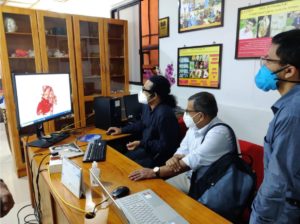 Dr. Mahesh is now working on creating a digital morphology library and museum that can be accessible to medical professionals and students from anywhere in the world.
Dr. Mahesh is now working on creating a digital morphology library and museum that can be accessible to medical professionals and students from anywhere in the world.
AIMS collaborates with many institutions across the world to exchange 3D files and discuss complex cases. Dr. Mahesh is confident that collaboration between hospitals is essential when using new technologies.
“Not all hospitals in low- and middle-income countries can afford to have a dedicated congenital heart MRI program or a person who is an expert in interpreting MRI and CT accurately,” says Dr. Mahesh. “But the way the technologies go, there is going to be a democratization of that. If we have a few heart centers capable of doing this, they could serve other centers with greater limitations in resources. The hospitals that can’t afford this can get cardiac scans done and upload these scans to the Cloud. And the centers like ours could bring these scans into 3D formats and share their expertise. Through active collaboration, it’s quite possible to do this.”
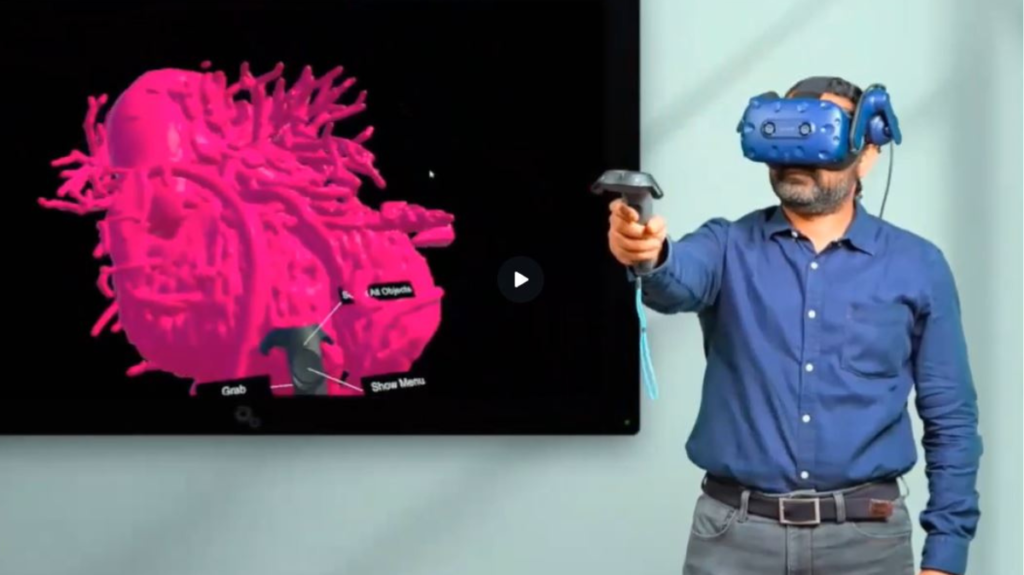
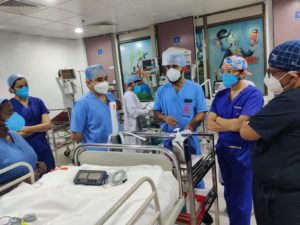
Amrita Institute of Medical Sciences (AIMS) has been a Children’s HeartLink partner since 2002. With the help of our medical volunteers from top medical institutions, AIMS built a strong pediatric cardiology program and developed strong connections with community providers through years of outreach and awareness building. This, coupled with their steadfast commitment to excellence and quality, has helped them grow into one of the most advanced pediatric cardiac centers in the country. AIMS has received many accolades and recognition for its standards of care. As a Children’s HeartLink Center of Excellence since 2012, the team has begun to support cardiac professionals from India and other countries. AIMS is also a key partner in Children’s HeartLink’s efforts with the Government of the state of Kerala to increase access to and improve pediatric care at public hospitals.
Children’s HeartLink saves children’s lives by transforming pediatric heart care in underserved parts of the world. Founded in 1969, we currently support 18 partner hospitals in Brazil, China, India, Malaysia and Vietnam. In 2021, our medical volunteers trained over 5,400 professionals and helped more than 122,000 children worldwide. Read more about our work.
Related blogs:
Dr. Mahesh and Hari Join Children’s HeartLink International Programs Committee
How a 3D Printed Heart Changed More Than One Life
Children’s HeartLink Center of Excellence in Kochi: Our Trainees Establish Cardiac Programs
